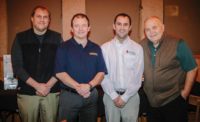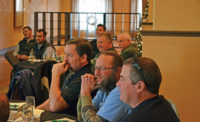Cutting-edge art and culinary schools, famous eateries, and an Ivy League college have helped Providence shed its reputation as just another Boston suburb. Rhode Island’s capital also boasts a new convention center and a revitalized waterfront that is widely recognized for its unique architecture.
Its sense of art and culture give flair to this city of 200,000 near the banks of Narragansett Bay, complete with artful re-use of turn-of-the-century factories and warehouses.
Many of the large, mostly post-and-beam buildings have found new life throughout the city in the form of museums, manufacturing spaces, condos, retail shops, and state-of-the-art medical facilities.
The Providence Center, a nonprofit behavioral health care organization, now occupies the 72,000-square-foot brick building that was once part of the Eagle Screw Co., founded in 1860. After being renovated to provide offices and meeting rooms, representatives from The Providence Center purchased the facility in 1996.
But it wasn’t until 2013 that a mechanical system retrofit brought all facets of the circa 1875 building into the 21st century. Operating costs fell while IAQ and comfort levels rose.
Dual Design
“These old brick buildings are solid and beautiful, but they sure don’t win any energy awards,” said Bob Pritchard, director of facilities and projects at The Providence Center. “We couldn’t keep the facility at a comfortable temperature in the winter and spent huge dollars attempting to do just that.
“Also, there are two full levels of the building below grade,” continued Pritchard. “The entire east side of the building has a 40-foot-tall flagstone foundation, which inherently means moisture within the envelope. Air quality was a concern year-round; the building was just damp and musty.”
Nobody would argue the building needed a mechanical retrofit, so once the Providence Center raised the funds, Victory Heating and Air Conditioning Co. Inc., Bellingham, Massachusetts, was hired to design and install components that would provide a solution. Don Fleck, systems engineer at Victory, brought in rep firm Emerson Swan Inc. during the design.
“The work was split into two phases; a hydronic retrofit in late 2011 and a more invasive air-side upgrade in early 2013,” said Tim Eaton, Emerson Swan.
Hydronic Makeover
Victory’s first stop was the basement boiler room. The four existing 1 MBtu oil boilers were consuming nearly 18,000 gallons of fuel oil annually.
Compared to the air-side retrofit that was to come, the boiler swap out was simple. The building’s existing fin-tube radiation was serviceable, as were a handful of fan-coil units in stairwells. One-by-one, the Victory crew removed the oil boilers and installed four Heat Transfer Products Inc. Mod Con 850 boilers. The new condensing boilers offer 96 percent efficiency, a vast improvement over the roughly 65 percent operational efficiency the facility offered before the retrofit.
“With four modulating boilers, each with a 5:1 turndown, this system literally has 20 stages of heat input,” said Fleck. “It’s like having 20 tiny boilers, and each one only turns on if it’s needed. So you’re never using more fuel than the building really needs.”
Taco Inc. pumps on the boilers and the building’s primary loop provide efficient, maintenance-free circulation. For further space and initial cost savings, Victory installed Taco Plus Two multipurpose valves with each secondary pump. The compact valve operates as five valves in one, combining all the functions that are normally required on the discharge side of a centrifugal pump in a single body: a shutoff valve, a non-slam check valve, a balancing valve, and a flow metering valve. It’s easily field-converted from a straight pattern to a 90-degree pattern for easy use in nearly any application.
Leadership at the Providence Center didn’t have to wait long to see the savings from the boiler retrofit. Fuel expenses were $66,000 less than the prior winter, which means that the estimated 4.8-year return on investment (ROI) is tracking nicely.
Air-side Needs
Meanwhile, according to Pritchard, the building smelled like damp earth.
“We knew we were using way too much electricity for air conditioning, and the temperature varied as much as 15?F from room to room,” he said. “The building’s 37 independent HVAC systems couldn’t maintain desired conditions.”
In 2013, work on the airside project started. Fleck and Eaton had designed a dedicated outdoor air system around a new product.
The solution to all ailments would come in the form of a packaged rooftop unit. The 20-ton Atherion, courtesy of Modine Mfg. Co., now installed at Providence Center is used for dedicated outdoor air supply. It features condensing gas heating technology and an optional 65 percent effective wheel-type energy recovery ventilator (ERV) module.
“When the day came to commission the Atherion, I’d never even seen one before,” said Gary Tsacoyianis, controls and startup technician for Victory. “You can tell right away that it’s very well built, and the onboard controls are intuitive.”
Esker MacConnell Sr., service technician for Modine, and Eaton were on site for commissioning, as well.
“My job was easy,” continued Tsacoyianis. “But I’m told the ductwork was another story.”
The most challenging part of the project came when Victory technicians installed 5,100 lineal feet of duct in the old building. The old brick and large timbers slowed progress, but, when the work was finished, there was neutral-temperature fresh-air delivery to the farthest reaches of the facility.
With the Atherion’s ERV module, a portion of the cooling load has been lifted from the existing independent systems, allowing them to easily meet demand.
Pressure Problems
“Before the retrofit, we had major issues with negative pressure in the building,” said Pritchard. “You had to heave on the door to get in the building. Once you had it open, it’d literally suck you in.”
Three vertical utility shafts in the building, plus the elevator shaft, acted as big chimneys, providing a perfect conduit for warm air to leave the building. This, and the building’s inoperable windows, created a vacuum.
As annoying as the pressure issue was, it also created a huge waste of energy as conditioned air was pulled out of the building, especially in the winter. During the retrofit, the shafts were used to run ductwork between the floors and then sealed off. But Victory took the pressure solution a step further. Aside from providing cost-effective make-up air, the Atherion is also tasked with maintaining positive pressure within the building.
A barometric pressure sensor in the building corresponds with the Atherion’s variable frequency drive (VFD)-powered fan in order to maintain the 0.02-inch H2O set point, similar to that of a typical pharmaceutical clean room.
“On average, the Atherion is exhausting 3,800 cfm and supplying 4,000 cfm,” said Tsacoyianis.
Home Run
“We’re absolutely 100 percent satisfied with the retrofit,” said Pritchard. “The energy savings are staggering, and the indoor environment isn’t even comparable.” But the project also resulted in a few less-tangible benefits.
The new controls system installed by Victory allows domestic water to be shutoff within the building during unoccupied hours, which is another big benefit because the facility had suffered a few overnight leaks in the past.
Programmable thermostats also mean the heating and cooling systems can be turned back over nights and weekends for maximum savings.
SIDEBAR: Project Benefits
• $66,000 annual fuel savings from heating retrofit alone;
• 4.8-year return on investment (ROI) remains on-track;
• Vastly improved IAQ;
• Negative pressure issues resolved;
• Boiler repair and maintenance now virtually nonexistent;
• Consistent temperatures throughout the building in heating and cooling mode;
• Programmable thermostats save energy during unoccupied hours; and
• Domestic hot water leaks are no longer a concern due to the new control system.
Publication date: 9/22/2014
Want more HVAC industry news and information? Join The NEWS on Facebook, Twitter, and LinkedIn today!






